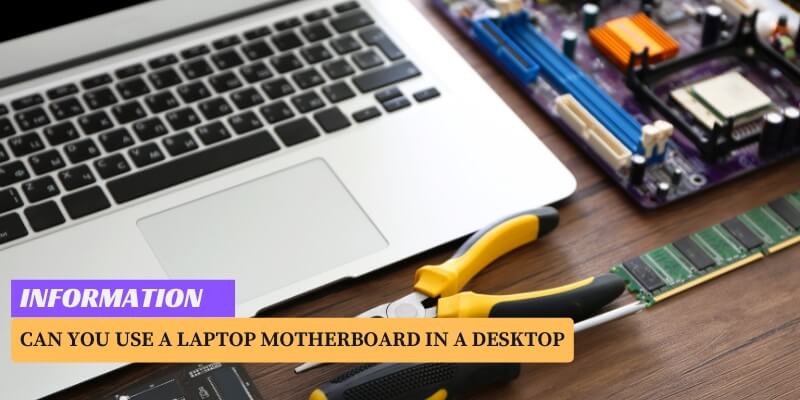
No, a laptop motherboard cannot be used in a desktop. The form factors and connectors of laptop and desktop motherboards are different, making them incompatible with each other.
Additionally, the power requirements and cooling systems for laptops and desktops differ significantly, further preventing the use of laptop motherboards in desktops.
Laptop and desktop systems differ in various aspects, including their internal components. While both laptops and desktops contain a motherboard, they are designed differently and thus cannot be interchangeable.
The motherboard serves as the central hub that connects all the computer’s components, including the CPU, RAM, and storage devices.
In the laptop form factor, the motherboard is specifically designed to fit within the constraints of a compact and portable casing. On the other hand, desktop motherboards are larger and can accommodate more expansion slots, ports, and connectors.
We will explore the reasons why it is not possible to use a laptop motherboard in a desktop system and the incompatibilities that arise between the two.
Table of Contents
Understanding The Compatibility Factors
When it comes to building or upgrading a desktop computer, one question that often arises is whether you can use a laptop motherboard in a desktop.
This is a valid query, as laptop and desktop motherboards have some fundamental differences that could potentially affect their compatibility.
In this article, we will delve into the important compatibility factors and shed light on why using a laptop motherboard in a desktop might not always be a straightforward task.
Differences between laptop and desktop motherboards
It is important to understand that laptop and desktop motherboards are designed for different purposes and environments. Laptop motherboards are specifically engineered to meet the space constraints and power requirements of portable computers.
On the other hand, desktop motherboards are optimized for larger form factors and different power consumption needs.
Examining the form factor and size differences
One of the key factors that differentiate laptop and desktop motherboards is their form factor and size. Laptop motherboards are significantly smaller and more compact compared to desktop motherboards.
This compact design allows them to fit into the limited space within a laptop chassis. In contrast, desktop motherboards come in various form factors, such as ATX, Micro ATX, and Mini ITX, providing flexibility for different case sizes and expansion options.
Power requirements and connectors:
Another crucial aspect to consider is the power requirements and connectors used by laptop and desktop motherboards. Laptop motherboards are designed to operate on lower voltages, usually in the range of 3.3V to 5V.
Desktop motherboards, in contrast, have higher power requirements and often rely on a 12V rail for various components.
Additionally, the power connectors used on laptop and desktop motherboards may also differ, making it challenging to connect a laptop motherboard to a desktop power supply unit.
Ensuring compatibility:
Before even considering using a laptop motherboard in a desktop, it is essential to check for compatibility between the two. Apart from the physical differences, there are also compatibility issues regarding CPU sockets, RAM slots, expansion slots, and other features.
The motherboard form factor and socket type must match those of the CPU for successful installation and operation.
While it might be tempting to repurpose a laptop motherboard for use in a desktop, it is crucial to weigh the compatibility factors.
The differences in form factor, power requirements, and connectors make it challenging to seamlessly integrate a laptop motherboard into a desktop environment.
However, if compatibility is ensured and all necessary modifications are made, it is not entirely impossible to use a laptop motherboard in a desktop system.
Necessary Modifications And Adapters
Are you considering repurposing a laptop motherboard for your desktop? It’s not an uncommon practice among tech enthusiasts and DIY enthusiasts.
However, there are necessary modifications and adapters you need to consider before attempting this compatibility merge.
In this article, we will discuss the crucial steps you should take to adapt a laptop motherboard to fit your desktop case, connect the desktop power supply, and identify and adapt to different input/output connectors.
Adapting The Laptop Motherboard To Fit The Desktop Case
When it comes to fitting a laptop motherboard into a desktop case, there are a few physical and structural considerations you need to keep in mind.
Since laptop motherboards are smaller than desktop motherboards, you may face challenges in aligning screws and matching mounting holes. However, with some ingenuity and the right tools, you can overcome these obstacles.
To adapt the laptop motherboard to fit your desktop case, follow these steps:
- Measure and mark the locations for new mounting holes on the desktop case.
- Using a drill and appropriate drill bit, create the new mounting holes in the case.
- Align the laptop motherboard with the new mounting holes and secure it in place using screws or standoffs.
By following these steps, you can ensure a secure fit for your laptop motherboard within your desktop case, allowing for a seamless integration of the two systems.
Connecting The Desktop Power Supply To The Laptop Motherboard
The next step in using a laptop motherboard in a desktop setup is connecting the desktop power supply to the laptop motherboard.
Since laptop motherboards have different power connectors compared to desktop motherboards, you’ll need to make some modifications to establish a stable power supply.
To connect the desktop power supply to the laptop motherboard, you’ll need to:
- Identify the power connectors present on the laptop motherboard.
- Adapt or replace these connectors with compatible ones that match the ports of your desktop power supply.
- Connect the power supply cables securely and ensure proper power delivery to the motherboard.
By following these steps, you can successfully power your laptop motherboard using a desktop power supply, enabling the functioning of all components and peripherals.
Identifying And Adapting To Different Input/output Connectors
One crucial aspect to consider when using a laptop motherboard in a desktop system is the compatibility of input/output connectors.
Laptop motherboards often have different connectors compared to desktop motherboards, necessitating identification and adaptation to ensure proper connectivity.
To identify and adapt to different input/output connectors, follow these steps:
- Study the laptop motherboard thoroughly and make a note of the connectors available.
- Identify the corresponding connectors on the desktop case or expansion slots.
- Obtain the necessary adapters or cables to bridge the connection between the laptop motherboard and the desktop case, ensuring compatibility.
Through proper identification and adaptation, you can successfully integrate your laptop motherboard into a desktop system, ensuring seamless functionality of all components.
Repurposing a laptop motherboard for a desktop system is possible with the right modifications and adapters.
By adapting the laptop motherboard to fit the desktop case, connecting the desktop power supply, and identifying and adapting to different input/output connectors, you can efficiently merge the two systems to create a functional desktop setup.
However, it is important to note that the compatibility and performance of this setup will depend on the specific laptop motherboard and the desktop case you use. So, proceed with caution and ensure thorough research before embarking on this endeavor.
Bios And Driver Considerations
When it comes to using a laptop motherboard in a desktop, there are a few important considerations that need to be taken into account.
Two crucial aspects that need attention are updating the BIOS for compatibility and installing the necessary drivers for the laptop motherboard.
Additionally, configuring the BIOS settings for optimal performance is also imperative. Let’s explore each of these aspects in detail.
Updating The Bios For Compatibility
Updating the BIOS is a critical step in ensuring that the laptop motherboard is compatible with the desktop system.
The BIOS, or Basic Input/Output System, is responsible for initializing and configuring the hardware components of a computer. It contains firmware that controls the interaction between the operating system and the motherboard.
To update the BIOS, you will need to visit the manufacturer’s website and search for the latest BIOS version for your laptop motherboard.
Once you have downloaded the BIOS update file, follow the instructions provided by the manufacturer to install it. Keep in mind that updating the BIOS can be risky, so it’s essential to read and follow the instructions carefully to avoid any potential issues.
Installing The Necessary Drivers For The Laptop Motherboard
After updating the BIOS, the next step is to install the necessary drivers for the laptop motherboard. These drivers enable the operating system to communicate effectively with the hardware components of the motherboard.
Without the proper drivers, you may experience compatibility issues or limited functionality.
To install the drivers, you can typically find them on the manufacturer’s website under the support or downloads section.
Locate the drivers specific to your laptop motherboard model and operating system, and then download and install them according to the provided instructions. It’s crucial to ensure that you have the correct drivers to avoid compatibility problems.
Configuring The Bios Settings For Optimal Performance
Once the BIOS is updated and the drivers are installed, the final step is to configure the BIOS settings for optimal performance. The BIOS settings determine how the motherboard interacts with the components and peripherals of the desktop system.
By adjusting these settings, you can optimize the performance of your laptop motherboard in the desktop setup.
| Configuring the BIOS settings for optimal performance: |
|---|
| 1. Access the BIOS settings by pressing the designated key during system startup (often indicated on the screen). |
| 2. Navigate to the relevant sections (such as CPU, RAM, and storage) and make adjustments based on your specific requirements and hardware. |
| 3. Save the changes and exit the BIOS. |
By configuring the BIOS settings properly, you can ensure that your laptop motherboard performs optimally in the desktop system, maximizing its capabilities and avoiding any potential performance bottlenecks.
Potential Challenges And Workarounds
Using a laptop motherboard in a desktop can be a cost-effective solution for many users. However, this process is not without its challenges.
In this section, we will explore some of the potential hurdles you may encounter when using a laptop motherboard in a desktop setup and provide workarounds to help you overcome them.
Dealing With Unsupported Hardware Components
One of the main challenges you may face when using a laptop motherboard in a desktop is compatibility with hardware components. Laptop motherboards often have different form factors and socket types compared to desktop motherboards.
This means that certain components such as the processor, memory, and expansion cards may not fit properly or be compatible with the laptop motherboard.
To address this issue, it is important to research and carefully select hardware components that are compatible with the laptop motherboard. Look for components that have the same form factor and socket type as the laptop motherboard.
Additionally, check the motherboard manufacturer’s website for a compatibility list or consult with a computer hardware expert for guidance.
By ensuring compatibility, you can avoid any potential issues and make the most of your laptop motherboard.
Addressing Overheating And Cooling Issues
Another challenge that may arise when using a laptop motherboard in a desktop is overheating.
Laptop motherboards are designed to operate within the limited space and airflow of a laptop chassis, which may not be sufficient for a desktop environment with higher power demands.
To address this challenge, it is crucial to provide adequate cooling for your laptop motherboard. Consider installing additional case fans or upgrading your CPU cooler to ensure proper heat dissipation.
You can also monitor the temperature of your laptop motherboard using software tools and adjust the fan speeds accordingly.
By addressing overheating and ensuring proper cooling, you can prevent potential damage to the motherboard and maintain optimal performance.
Troubleshooting Common Issues And Finding Solutions
When using a laptop motherboard in a desktop, it is important to be prepared to troubleshoot common issues that may arise. These can range from compatibility problems with drivers and software to connectivity issues and power supply constraints.
To effectively troubleshoot and find solutions, start by identifying the specific problem you are facing. Check for any error messages, consult online forums, or seek assistance from the motherboard manufacturer’s support team.
It is also helpful to keep your motherboard’s BIOS and drivers up to date, as this can often resolve compatibility and performance issues.
Furthermore, being familiar with the basic principles of computer hardware can help you detect and diagnose any potential issues.
By understanding the different components and their interactions, you can more easily identify the source of a problem and find appropriate solutions.
Overall, while using a laptop motherboard in a desktop setup offers its own set of challenges, with careful planning and troubleshooting, you can overcome these hurdles and create a functional and cost-effective computer system.
By addressing compatibility concerns, ensuring proper cooling, and being proactive in troubleshooting, you can make the most of your laptop motherboard and enjoy a seamless desktop computing experience.
Benefits And Limitations Of Using A Laptop Motherboard In A Desktop
Considering the possibility of using a laptop motherboard in a desktop can be an effective way to save costs and optimize resources.
This article explores the benefits and limitations of such a setup, shedding light on the key factors to consider before making a decision.
Cost Advantages And Budget-friendly Options
One significant benefit of using a laptop motherboard in a desktop is the potential cost savings it offers. Laptop components, including motherboards, are often more affordable compared to their desktop counterparts.
This can be especially advantageous for those on a budget or looking to build a cost-effective desktop system.
However, it’s important to consider the specific requirements and compatibility of the laptop motherboard with the desktop system.
While the initial cost may be lower, there might be additional expenses involved in adapting the laptop motherboard to fit the desktop’s form factor or installing compatible components.
Factors To Consider When Choosing A Laptop Motherboard For A Desktop
When opting to use a laptop motherboard in a desktop, several factors should be taken into account:
- Form factor compatibility: Ensure that the laptop motherboard’s form factor is compatible with the desktop case.
This will save you from potential issues when it comes to fitting the motherboard securely and accessing the necessary ports and connectors. - Processor compatibility: Check if the laptop motherboard supports your desired processor. Different laptop models may have varying processor socket types, and it is crucial to choose a motherboard that can accommodate your preferred processor.
- Expansion slots and connectors: Evaluate the laptop motherboard’s available expansion slots and connectors.
Consider your specific needs for graphics cards, storage drives, and other peripherals. Make sure the laptop motherboard offers enough compatibility to suit your desired desktop configuration. - Power requirements: Verify the power requirements of the laptop motherboard and ensure that your desktop’s power supply unit can meet those needs.
- BIOS compatibility: Confirm if the laptop motherboard’s BIOS is compatible with the desktop system. BIOS compatibility ensures smooth booting and optimal functioning of the motherboard within the desktop environment.
Knowing The Limitations And Potential Performance Trade-offs
While using a laptop motherboard in a desktop can be a cost-effective solution, it is important to be aware of potential limitations and performance trade-offs:
- Upgrade limitations: Laptop motherboards are generally designed to be compact and optimized for specific components. This can limit the ability to upgrade or replace certain hardware components, such as graphics cards or processors.
- Thermal and cooling considerations: Laptop motherboards may not have the same level of thermal management capabilities as desktop motherboards.
Ensuring adequate cooling and airflow within the desktop case becomes crucial for maintaining optimal operating temperatures. - Performance trade-offs: Laptop motherboards typically prioritize power efficiency to preserve battery life.
While they can deliver adequate performance for everyday tasks, they may not offer the same level of performance as desktop motherboards designed for heavy-duty computing. - Limited expansion options: Due to their compact size, laptop motherboards often have fewer expansion slots and connectors compared to desktop motherboards. This restricts the ability to add additional hardware components or peripherals to the desktop system.
Considering these limitations and potential trade-offs will help you make an informed decision when opting to use a laptop motherboard in a desktop setup.
Weighing the cost advantages and compatibility factors against the potential performance and upgrade restrictions is crucial to determine if this solution aligns with your specific needs and requirements.
FAQs Of Can You Use A Laptop Motherboard In A Desktop
Can I Use Laptop Components In A Pc?
Yes, laptop components can be used in a PC. Both laptops and PCs use similar hardware components such as processors, RAM, and storage devices. However, compatibility issues may arise due to differences in form factor and connection types. It’s important to check the specifications and ensure that the components are compatible before making any upgrades or replacements.
What Is The Difference Between Desktop Motherboard And Laptop Motherboard?
The main difference between desktop motherboards and laptop motherboards is their physical size. Desktop motherboards are larger and have more expansion slots for additional components, while laptop motherboards are smaller and have integrated components to save space.
What Can I Do With My Old Laptop Motherboard?
You can repurpose your old laptop motherboard by selling it for parts, recycling it, or using it in a DIY project.
Are Laptop Motherboards Different?
Yes, laptop motherboards can be different. Different laptop models may have varying motherboard sizes, layouts, and connector placements. It is important to match the specific motherboard with the laptop model for compatibility and proper functioning of the device.
Can I Use A Laptop Motherboard In A Desktop?
Yes, you can’t use a laptop motherboard in a desktop as they have different form factors and connectors.
Is It Possible To Swap A Desktop Motherboard With A Laptop Motherboard?
No, desktop motherboards are larger and have different spacing for components compared to laptop motherboards.
Can I Upgrade My Desktop With A Laptop Motherboard?
No, desktops and laptops have different architectures and components, so they are not compatible.
What Are The Differences Between Laptop And Desktop Motherboards?
Laptop motherboards are smaller, have integrated components, and use different connectors compared to desktop motherboards.
Can I Use Laptop Components On A Desktop Motherboard?
In most cases, you cannot use laptop components on a desktop motherboard due to differences in form factors and compatibility.
Conclusion on Can You Use A Laptop Motherboard In A Desktop
With advancements in technology, the compatibility between laptops and desktops has become a common question.
While using a laptop motherboard in a desktop may seem like a viable option, it is important to consider the compatibility issues and potential hardware limitations.
It is always recommended to use a motherboard specifically designed for a desktop to ensure optimal performance. Make informed decision and consult a professional if needed.





